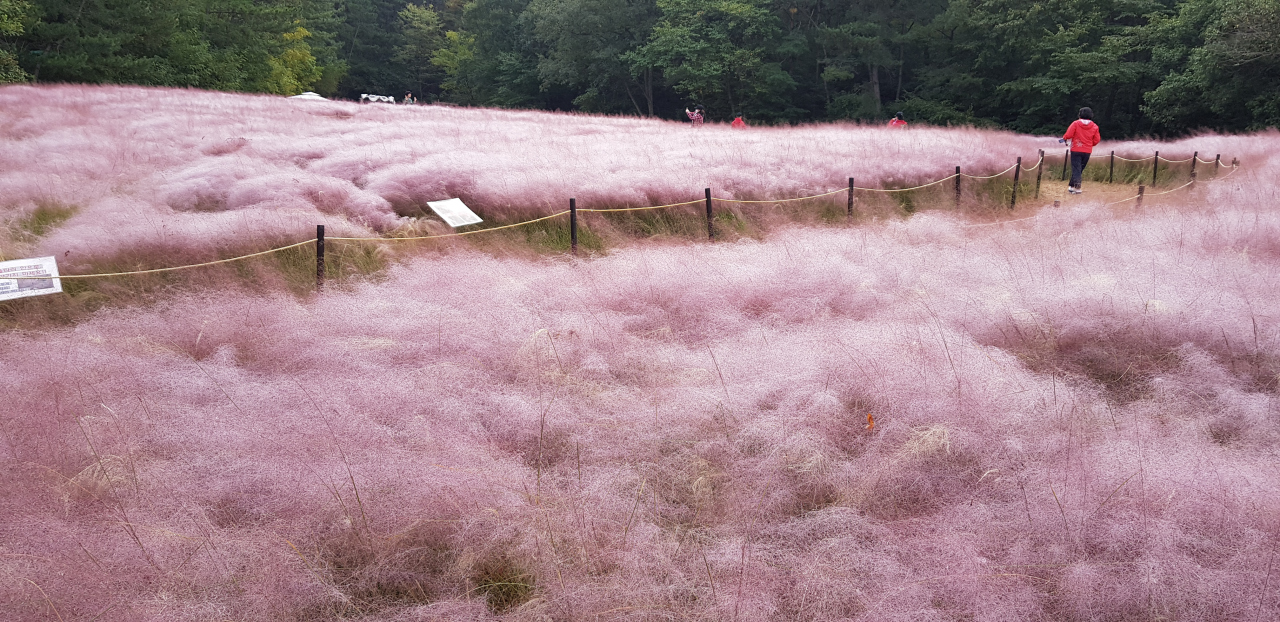[Weekender] The pink invasion
Exotic imported pink grass is the star of autumn gardens
By Lee Sun-youngPublished : Oct. 4, 2019 - 10:01
Pink is the most sought-after autumn color in South Korea right now.
Do an Instagram search for #pinkmuhly and you’ll get an idea of what’s going on. There are over 300,000 posts, many showing couples, children and young women posing in picturesque gardens full of pink grass.
Surreal displays of pink and purple inflorescences, floating above tall grass like soft clouds, have popped up in so many cities and towns that they are difficult to keep track of: Seoul, Busan, Jeju, Ulsan, Yeoju, Gyeongju, Andong, Daejeon, Hampyeong, Pocheon and Suncheon are just a few.
Do an Instagram search for #pinkmuhly and you’ll get an idea of what’s going on. There are over 300,000 posts, many showing couples, children and young women posing in picturesque gardens full of pink grass.
Surreal displays of pink and purple inflorescences, floating above tall grass like soft clouds, have popped up in so many cities and towns that they are difficult to keep track of: Seoul, Busan, Jeju, Ulsan, Yeoju, Gyeongju, Andong, Daejeon, Hampyeong, Pocheon and Suncheon are just a few.

Providing the perfect backdrop for that once-in-a-lifetime photo, these gardens are expected to draw large crowds again this fall.
“I saw the pink grass for the first time during my trip to Jeju three years ago. Now there are a couple of pink muhly gardens not far away from where I live, which is good because they are great photo spots,” said Lee Sun-hye, an office worker in Seoul.
The plant, Muhlenbergia capillaris, more commonly known as the hairawn muhly, is a perennial native to North America. Heat- and drought-resistant and suitable for almost any type of soil, it grows about 30-90 centimeters tall and blooms from September to November.
It is believed to have made its debut in Korea just five years ago: A private park on the southern island of Jeju claims to have started the nation’s first pink garden in 2014.
Since then, several cities and districts have had muhly seeds flown in from overseas and planted them along riverbanks, fields, parks and roads.
According to Environment Ministry data released by the office of Rep. Shin Chang-hyun, a combined 112,000 square meters -- the equivalent of 15 soccer fields -- of muhly habitats were created by local governments and state-run organizations last year alone. There is no data on the plant’s presence on private land.
Experts and the Environment Ministry are keeping an eye on potential risks to ecosystems.
“The plant grows and adapts well to different soil conditions. A study on its possible impact on the ecosystem may be desirable,” said Sohn Dong-chan, a researcher at the Korea National Arboretum.
The Environment Ministry is reportedly considering conducting a biosecurity risk analysis later this year.
By Lee Sun-young (milaya@heraldcorp.com)












![[Today’s K-pop] BTS pop-up event to come to Seoul](http://res.heraldm.com/phpwas/restmb_idxmake.php?idx=644&simg=/content/image/2024/04/17/20240417050734_0.jpg&u=)





![[KH Explains] Hyundai's full hybrid edge to pay off amid slow transition to pure EVs](http://res.heraldm.com/phpwas/restmb_idxmake.php?idx=652&simg=/content/image/2024/04/18/20240418050645_0.jpg&u=20240418181020)

![[Today’s K-pop] Zico drops snippet of collaboration with Jennie](http://res.heraldm.com/phpwas/restmb_idxmake.php?idx=642&simg=/content/image/2024/04/18/20240418050702_0.jpg&u=)